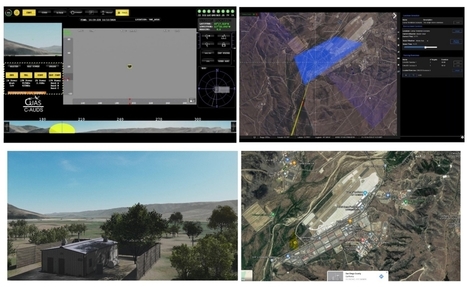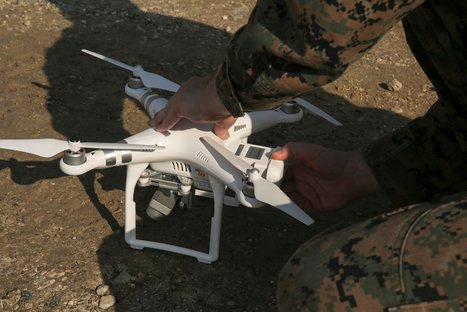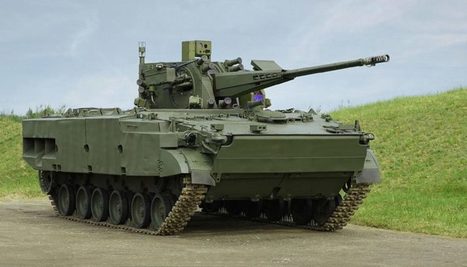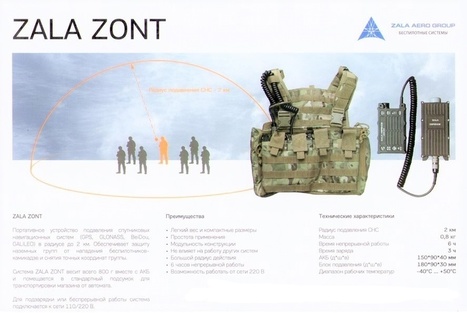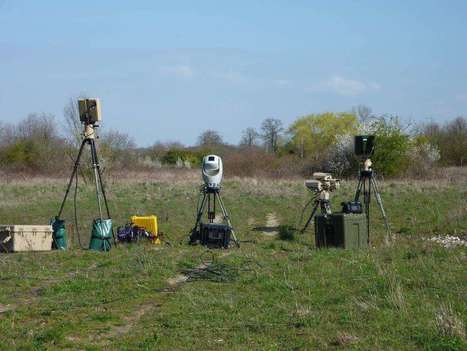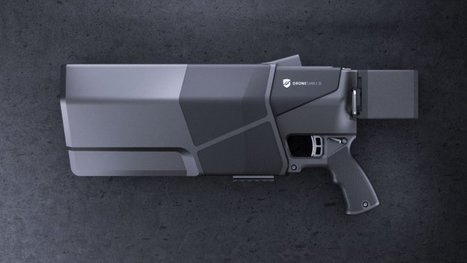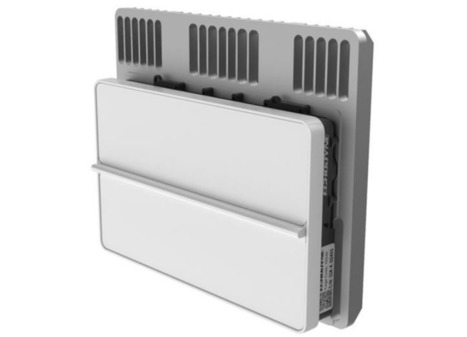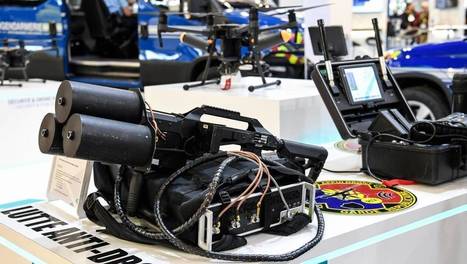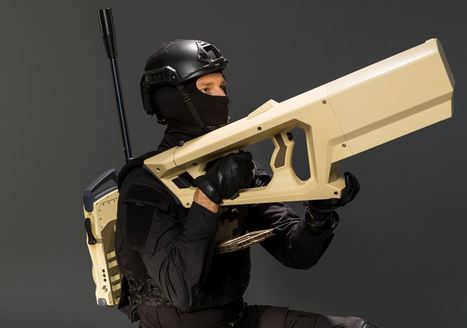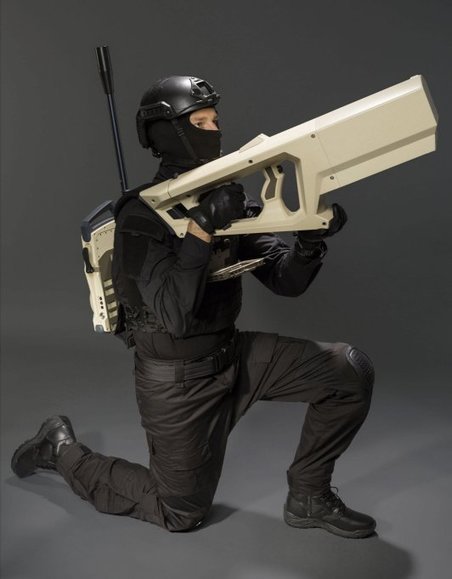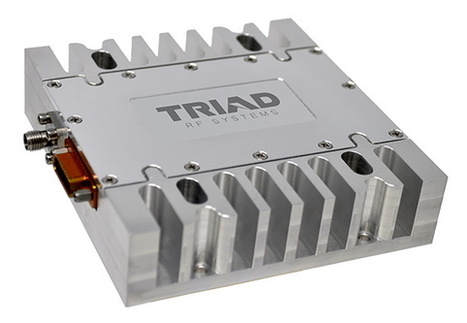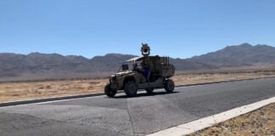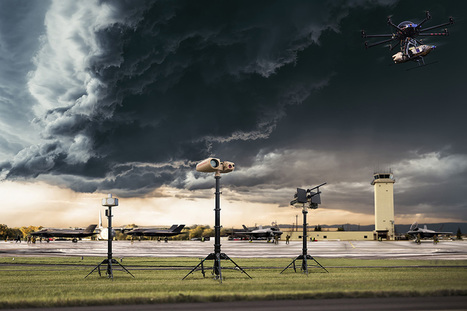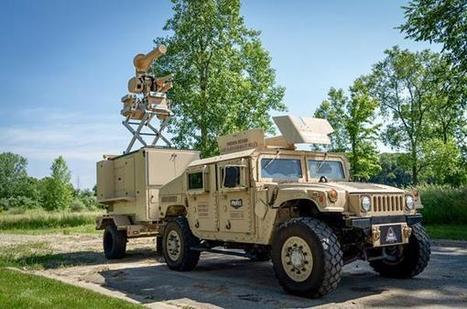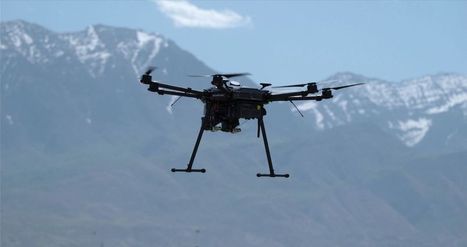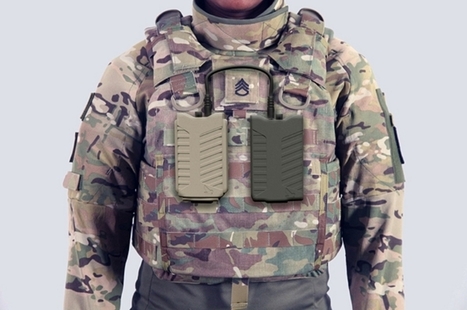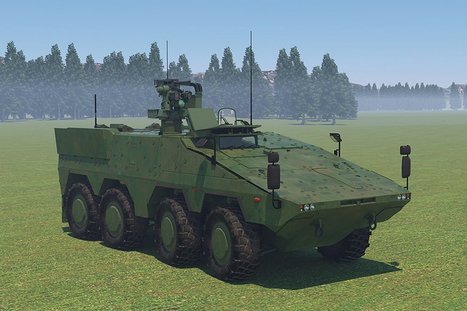 Your new post is loading...
 Your new post is loading...

|
Scooped by
Romain
October 22, 2020 12:05 AM
|
Liteye Systems, Inc., Numerica and AEgis Technologies Group have announced the joint development of a high-fidelity C-UAS (Counter-Unmanned Aircraft Systems) Modelling, Simulation and Training system, the Liteye C-UAS Simulator.
The Team identified an industry need to enhance the traditional hands-on individual and classroom training currently being provided to operators and service representatives for Liteye’s Anti-UAS Defense System (AUDS) across the world. The Liteye C-UAS Simulator incorporates a high-fidelity virtual environment tied to the actual Liteye AUDS Command, Control (C2) and user Interface. The combination of the virtual environment and the operational C2 Interface provide the most advanced realistic simulation and training system available.
“It’s difficult and cost prohibitive to find realistic, full-mission test and training locations within the United States every time a new threat hits the street,” said Zac Neumayr, VP of Field Operations at Liteye. “Our Simulator allows a trained operator to remain proficient and develop new techniques and procedures to successfully defend personnel and critical infrastructure around the world. Liteye’s AUDS remains one of the most effective systems employed as part of an integrated ground and air defense solution. The addition of the Liteye C-UAS Simulator is another in the long list of tools under development by our team to stay ahead of the current and future threats.”
“The technical designs and performance of small UAS are increasing rapidly as is the propensity for them to be used in a malicious and deadly way,” said Ryan Hurt, VP of Business Development at Liteye. “Having the Liteye C-UAS Simulator as a backstop, we can rapidly evaluate the best tactics, techniques, and procedures to counter new threats by adding the threat profile to the simulation and develop the counter-tactics. With the Simulator, Liteye trained operators have the tools they need to develop C-UAS tactics faster than new threats can be developed.”
Liteye’s AUDS is Combat Proven to disrupt and neutralize UAS engaged in hostile airborne surveillance and potentially malicious activity against critical infrastructure sites. Combining electronic-scanning radar target detection, electro-optical (EO) tracking and classification, and directional radio frequency (RF) inhibition capability, the AUDS smart-sensor and effector package is capable of remotely detecting and tracking small UAS, classifying potential threat, and providing the option to disrupt activity.
Liteye C-UAS Simulator creates high fidelity virtual environment
AEgis is a US defense industry trailblazer in custom Virtual Reality simulators, providing 360° immersive, high-fidelity virtual environments that transform traditional training into a repeatable, lasting experience that enhances end-user’s operational readiness. AEgis’ expansive collection of simulators includes the VAMPIRE Suite of Simulations, a fully embedded UAS training simulation with more than 9,000 fielded systems delivered to 7 countries, all Department of Defense (DoD) services, and multiple government agencies.
Source: Press Release

|
Scooped by
Romain
October 13, 2020 12:36 AM
|
The U.S. Army News Service has announced that the Department of Defense is slated to release its counter-small unmanned aircraft systems strategy next month, bringing an open-system architecture and enterprise approach to the military’s capabilities.
The Army-led Joint C-sUAS Office, or JCO, has worked to align current and future counter-drone technologies to support operational requirements at home and abroad, said Maj. Gen. Sean A. Gainey, the program’s director.
The increased threat posed by drones, combined with a lack of dependable networked capabilities to counter the unmanned threat, has created a concerning “tactical development” within U.S. Central Command’s area of responsibility, Gainey said, paraphrasing a recent statement made by its commander.
Classification of unmanned aircraft systems is divided into five category groups. The defense secretary appointed the Army as the executive agent for counter-small UAS groups one through three, said Col. Richard Wright, the JCO deputy director.
These first three categories represent smaller, low-cost drones, whose rapid proliferation can threaten personnel and critical assets, or impact the military’s ability to conduct various operations. Groups four and five identify larger UASs typically controlled by state-actor threats, according to JCO officials.
Close to 90% of the military’s counter-drone capabilities are electronic warfare-type systems, Gainey said. Many of these weapons use lasers or microwave-signal propagation to disrupt the communications link between user and device.
“However, the threat is evolving,” Gainey added, as the joint force now has to account for swarm and autonomous drones, in addition to off-the-shelf technology. Further, an increased number of threats in an airspace can potentially overwhelm a C-sUAS system’s operator.
This shift led the JCO to revise the Defense Department’s C-sUAS requirements and build a networked systems approach. Officials are also considering artificial intelligence and machine learning options to help discriminate and track possible threats.
The Army also plans to incorporate its C-sUAS capabilities into the Integrated Air and Missile Defense Battle Command System, Gainey said. The new command system is currently going through the evaluation process by AMD entities and Army Futures Command.
Along with improving capabilities, leaders have identified the need to bolster training to improve the military’s counter-drone capabilities, Gainey said.
The Fires Center of Excellence at Fort Sill, Oklahoma, is expected to build a Joint C-sUAS academy by fiscal year 2024. The Fires CoE supports current training operations out of Yuma Proving Ground in Arizona.
“We can start to institutionalize this capability and integrate it with our air and missile defense systems,” Gainey added. “Having a synergy at the schoolhouse will help the force understand how to get after this problem from a DOTmLPF-P [or doctrine, organization, training, materiel, leadership and education, personnel, facilities and policy] perspective.”
Moving forward, the JCO will continue to work with the Army Rapid Capabilities and Critical Technologies Office to ensure the timely and proper fielding of C-sUAS systems, Gainey said.
To help industry partners understand the DOD’s emerging requirements and encourage competition, both the RCCTO and JCO are scheduled to conduct a C-sUAS virtual open house on Oct. 30. The JCO also plans to organize future industry demonstration days to identify and assess technologies against emerging threats, Gainey said.

|
Scooped by
Romain
October 5, 2020 12:30 AM
|

|
Scooped by
Romain
September 29, 2020 12:33 AM
|
Blighter Surveillance Systems, the British designer and manufacturer of electronic-scanning radars and surveillance solutions, has launched the latest in its range of market-leading radars, the A800 3D drone detection radar for land, air and sea surveillance.
The radar’s main function is to detect and locate commercial ‘hobby’ drones in 3D space. Its optimised air security mode provides a unique ability to search for low-slow-small (LSS) threats caused by the misuse of small drones including the commonly-used ‘DJI Phantom’ style quadcopters. An Artificial Intelligence based micro-Doppler target filtering feature helps to reduce false alarms and improve the detection of multi-copter and winged drones.
“We continue to develop and extend our product range to keep Blighter at the forefront of radar capability and to meet the growing global need for effective technical solutions to counter the malicious use of drones,” said Angus Hone, CEO of Blighter Surveillance Systems. “The new A800 tri-mode 3D radar offers revolutionary capabilities by performing precision surveillance in three complex environments at once using a single, cost-effective sensor.”
The A800 3D drone detection radar is designed to provide the earliest possible warning of incoming threats, by looking well beyond and above the perimeter. Its rugged design allows it to operate in harsh conditions and temperatures, from -32°C to 65°C. An extended operating temperature version is also available. It can be mounted onto tripods and quadpods, land vehicles and trailers and fixed towers and masts for surveillance in a wide variety of settings.
A800 3D
A wide variety of industry standard interfaces are supported by the A800 including high grade encryption, and a software developer’s kit (SDK) is also available for download.
Source: Press Release

|
Scooped by
Romain
September 24, 2020 12:42 AM
|
UK-based Blighter Surveillance Systems has launched a new UAS detection radar called A800 3D for air, land and sea surveillance.
CEO Angus Hone claimed that the new solid-state radar ‘offers revolutionary capabilities by performing precision surveillance in three complex environments at once using a single, cost-effective sensor’.
The main function ...

|
Scooped by
Romain
September 21, 2020 12:16 AM
|
La jeune société russe Zala a présenté au salon Army2020 une innovation qui pourrait bien venir perturber le marché des systèmes anti-drones, et s’intégrer rapidement à la tenue des forces spéciales russes.
Spetsnaz
Le Zont (parapluie en russe) présente tous les aspects d’un gilet pare-balles, mais il est en fait doté d’un émetteur alimenté par une batterie qui brouille les systèmes de localisation par satellite qui sont utilisés par les drones. Et ce tant pour le système GPS ou Galileo, que Glonass ou Beidou. D'un poids de seulement 800g tout équipé pour une autonomie de 6h , il opère sur un rayon de 2 km. Enfin, pour répondre à l'hétérogénéité des théâtres d'opérations des spetznaz son fonctionnement est garanti de -40 à +50°C. Après la présentation d'un premier prototype en 2018 aux forces armées russes, le Zont serait actuellement expérimenté sur un théâtre extérieur.
Politique Produit
C’est en raison du nombre de pertes humaines occasionnées par les drones kamikazes employés sur le front syrien, que la société Zala, filiale du groupe Kalachnikov et fournisseur attitré des forces spéciales russes, a développé au cours des trois dernières années une gamme de produits destinée à neutraliser les données de localisation par satellite. Zala a tout d’abord lancé les fusils anti-drones Rex-1 et 2, mais comme toutes les solutions occidentales analogues ces produits nécessitent de visualiser avec précision la menace, de mobiliser plusieurs opérateurs pour couvrir toutes les directions, et d’être inefficace en cas d’attaque par saturation. Aussi en complément du Zond, Zala a réalisé à la demande des forces spéciales russes un mini-drone, le Zala 421-16E, qui brouille pendant plusieurs heures les liaisons de données et les signaux de navigation par satellites dans une sphère de 5 km autour d'un commando.
Reportage Spécial
Des drones de reconnaissance au UCAV, des pods ISR aux systèmes anti-drones, la Russie réalise actuellement un retour spectaculaire dans le domaine des plateformes non pilotées comme l'a démontré le dernier salon Army2020 qui s'est déroulé fin août à Kubinka dans la banlieue de Moscou. Un reportage complet y sera consacré dans le numéro d'Air&Cosmos qui sortira le 25 septembre 2020.

|
Scooped by
Romain
September 16, 2020 12:11 AM
|
A-Tech Corporation (trading as Applied Technology Associates) has been awarded a $17.66 million project agreement by the US Air Force Life Cycle Management Center, to provide a prototype ground-based directed energy weapon for fixed-site airbase defence against Group 1 and Group 2 UAS threats.
‘The objective of the Directed ...

|
Scooped by
Romain
September 14, 2020 12:04 AM
|
CS GROUP a organisé des démonstrations de ses systèmes Boreades, CRIMSON et Starlink sur le centre d'essais en vol de Bretigny.
Démonstration.
Mercredi 9 octobre, CS Group a réalisé plusieurs démonstrations à Bretigny, mettant en scène son système anti-drones, ainsi que son C2. A cette occasion, CS GROUP avait déployé trois radars sur site, un longue portée de Saab (le G1X), un moyenne portée de Flir et un courte portée dont le constructeur n'a pas été dévoilé. L'ambition était ainsi de pouvoir suivre en temps réel la progression de drones à différentes distances. L'ensemble du système était par là même connecté au système UTM d'ASD, permettant également de faire apparaître les drones enregistrés à l'écran. Via ces démonstrations, CS GROUP souhaitait démontrer sa capacité à intégrer plusieurs systèmes ensemble et à agréger au sein d'un C2 les données issues de différents capteurs, dont celles provenant de Boreades.
Hypervision.
CS GROUP présentait par là même un système dit d'hypervision, CRIMSON, permettant de « faire remonter des informations depuis plusieurs superviseurs », nous explique l'entreprise. Et ce avant d'ajouter que l'information récupérée depuis des minis C2 et les capteurs peut être restituée en temps réel. « Crimson donne la situation tactique de ce qui se passe au sol. Nous pouvons également y connecter la troisième dimension et ainsi intégrer la position des drones amis et ennemis », complète CS GROUP.
CDAOA.
Avec ces démonstrations, CS GROUP a ainsi souhaité démontrer aux gestionnaires d'infrastructures critiques et au CDAOA, au niveau militaire, sa capacité à interconnecter différentes briques de la lutte anti-drones, en allant de la détection à la neutralisation. « La lutte anti-drones fait partie d'un système de sûreté aérienne », résume l'industriel.

|
Scooped by
Romain
September 7, 2020 12:56 AM
|
Leonardo has delivered the first of four complete counter-drone systems to the UK Royal Air Force (RAF), to support research and development for the ongoing ORCUS Counter-Unmanned Aerial System (C-UAS) program. ORCUS is a key part of the RAF’s testing and evaluation campaign that aims to improve understanding of how C-UAS technology can be deployed to battle the threat posed by hostile drones.
The study program, managed by Defence Equipment & Support Future Capability Group, is considered by the UK Ministry of Defence to be extremely important for national security. The RAF will maintain ORCUS as a national standby capability that can be rapidly deployed anywhere in the country to support emergency services during situations involving rogue UAS.
Leonardo’s modular C-UAS systems will allow the RAF to evaluate a range of anti-drone capabilities, including advanced radar, electro-optic and radio frequency sensors and an electronic attack countermeasure, with further subsystems to be integrated in the future. RAF Force Protection operators will be examining the most effective ways to detect, track, identify and defeat rogue drones, and the outcome of this research and development program will inform the requirements for a core RAF counter-drone capability that is intended to protect air bases around the UK.
Elements of Leonardo’s C-UAS equipment have previously been operated by the RAF Force Protection Force following drone sightings at Gatwick and Heathrow airports, allowing airport operations to resume. The company provides its scalable and modular C-UAS systems to various international military and civil customers, and is currently working with the Italian Army and Air Force.

|
Scooped by
Romain
August 27, 2020 7:02 AM
|
Epirus, a startup whose leadership team draws from Raytheon, Northrop and Silicon Valley, has landed its first deal with a name-brand defense prime.

|
Scooped by
Romain
August 18, 2020 4:16 AM
|
by Jon Grevatt
DroneShield, an Australian firm specialising in counter-unmanned aerial vehicle (UAV) technologies, has outlined plans to raise funds for expansion through the sale of shares.
The company said on 11 August that it aims to raise a total of AUD9 million (USD6.5 million) through two methods: a share placement and a share purchase plan. The placement will be held on 13 August, and the share purchase plan in September.
DroneShield - based in Sydney - has developed a range of counter-UAV products including this DroneGun MKIII: a lightweight jammer, which was launched in July 2019. (DroneShield)
DroneShield - based in Sydney - has developed a range of counter-UAV products including this DroneGun MKIII: a lightweight jammer, which was launched in July 2019. (DroneShield)
DroneShield aims to generate AUD7.5 million through the placement of 60 million shares and AUD1.5 million through the share purchase plan. The latter entitles shareholders to acquire shares up to the value of AUD30,000.
Under both sale methods, shares are being sold at AUD0.125. On 11 August DroneShield’s share were trading on the Australian Securities Exchange (ASX) at AUD0.14.

|
Scooped by
Romain
August 3, 2020 1:54 AM
|
DroneShield a remporté un contrat avec l'US Air Force visant à protéger la base aérienne de Grand Forks contre les drones.
Lutte anti-drones.
DroneShield a annoncé le 23 juillet avoir décroché un contrat avec l'US Air Force. Dans ce cadre, l'industriel fournira des solutions de lutte anti-drones pour protéger la base aérienne de Grand Forks, située dans le Dakota du Nord. Une option dans le contrat pourrait également permettre à l'USAF de se doter de systèmes supplémentaires.
Solution.
L'USAF a opté pour le système DroneSentry, permettant de détecter et neutraliser des drones intrus. Celui-ci se base sur une technologie d'analyse des radiofréquences afin de pouvoir identifier la position du drone. Un système de contremesures électroniques basé sur du brouillage permet par la suite de neutraliser l'aéronef.
Premier déploiement.
L'industriel a annoncé que ce contrat représentait le premier déploiement opérationnel de technologies DroneShield par l'USAF, qui remporte de nombreux succès commerciaux. Ainsi le 24 juillet, l'entreprise a annoncé avoir remporté une commande pour son système portable RadarZero de la part d'une armée européenne.

|
Scooped by
Romain
July 29, 2020 2:05 AM
|
by Gerrard Cowan
DroneShield’s first contract win with the US Air Force (USAF) was driven by its use of artificial intelligence (AI) in its counter-unmanned aircraft systems (C-UAS) products, with plans to further develop the technology across its range in the coming years, the company has told Janes.
DroneShield’s DroneSentry C-UAS system will be installed at Grand Forks Air Force Base. (DroneShield)
DroneShield’s DroneSentry C-UAS system will be installed at Grand Forks Air Force Base. (DroneShield)
The C-UAS specialist announced in late July that it had secured a deal to provide its DroneSentry C-UAS system for use at Grand Forks Air Force Base, with the potential for additional systems to be acquired after the initial deployment.
The system comprises the passive RfONE radio-frequency (RF) direction-finding sensors and DroneCannon soft-kill countermeasure systems, which forces intruding UASs into a fail-safe mode from which they either hover or slowly descend.
The systems will be deployed and operated at the base by the USAF’s 319th Security Forces Squadron (SFS). The use of AI appealed to the customer because of the limited impact that it has on manning while supporting UAS detection, according to DroneShield CEO Oleg Vornik.
AI provides several advantages when used with an RF-based system in UAS detection, Vornik told Janes. As RF is essentially a motion tracker and can pick up objects such as birds and moving trees, it may not detect a non-moving target such as a hovering UAS. He explained that AI provides “a smart way of analysing the RF spectrum” to assist with the identification of UASs.
The company will roll out AI across its suite of RF products in the short term, Vornik added, having already installed the technology in other parts of its range.
|

|
Scooped by
Romain
October 21, 2020 12:15 AM
|
Echodyne, the radar platform company, announced the release of EchoGuard CR and RadarHub to enable greater drone/aircraft detection in dense locations and simplify multi-radar deployment. These products represent a big step forward for the Counter-UAS space, broadening the capabilities of security systems in challenging environments.
EchoGuard CR provides high performance, active beam-steering, 3D radar capability in urban and dense environments or locations with reduced range requirements, and RadarHub simplifies multi-radar deployment and management.
The products extend Echodyne’s unique ability to bring high performance beam steering radar capabilities to commercial markets.
“We’re excited to continue to add to our product stack. Our new beam-steering radar, EchoGuard CR, brings highly accurate ground and airspace perimeter surveillance within the budget of the vast majority of critical infrastructure customers,” said Eben Frankenberg, CEO of Echodyne. “In addition, RadarHub provides a platform to easily deploy and manage multi-radar installations through one central interface and is a strategic addition to our expanding product lineup.”
EchoGuard CR
EchoGuard CR radar uses MESA radar technology to meet demand for high-performance radar for close range security within commercial budgets. The solution delivers advanced 3D perimeter surveillance for critical infrastructure with reduced energy output for greater accuracy in cluttered and busy semi-/urban environments.
EchoGuard CR’s ultra-low size, weight, and power (SWaP) is ideal for guarding ground and airspace perimeters of critical infrastructure and high-risk facilities in semi-/urban locations, and reliably identifies motionless or in-motion drones that may be spying from distance. A highly intuitive user interface allows configuration of the radar to site and mission requirements and offers options for integration into security platforms or as a stand-alone system. The lightweight solid-state hardware design simplifies mounting for fixed site deployments and offers rapid setup for portable or temporary needs.
RadarHub
RadarHub is a pre-engineered control cabinet solution that simplifies deployment, networking, and operations of multi-radar installations. The solution connects up to 5 radars and conveniently manages all key performance parameters, including power and network, through a single interface.
RadarHub is compatible with the growing EchoGuard family of radars and can be easily integrated with security system infrastructure or used to quickly deploy standalone hemispherical surveillance for temporary missions. Radar Hub provides flexible support for a variety of sensor fusion configurations such as radar + camera + additional sensors, e.g. RF or ADS-B, and has a UL-508A compliant design and construction.
Source: Press Release

|
Scooped by
Romain
October 10, 2020 6:26 AM
|
On ne fait pas n’importe quoi avec un drone. La réglementation est très stricte et pas question de faire voler ces engins dans n’importe quelle condition. Les gendarmes disposent aussi de nouveaux outils pour les repérer et les neutraliser si besoin.
"« L’utilisation des drones est très réglementée" , rappelle le chef d’escadron Laurent Chapparo, patron de la compagnie de Montfort-sur-Meu."Le vol de nuit est interdit sauf autorisations spéciales et ils ne doivent pas atteindre une altitude supérieure à 150 m. Le drone doit également toujours être visible à l’œil nu et rester dans le champ de vision du télépilote. "
Demande à la préfecture
Pas question non plus de le faire voler n’importe où. " Le vol est autorisé dans les espaces privés avec l’accord du propriétaire, dans les sites d’aéromodélisme autorisés, ou encore dans certains espaces publics. " En dehors de ces cas, des demandes d’autorisation sont à obtenir auprès des services de la préfecture.
Le vol de drones est aussi interdit au-dessus de certains sites sensibles ou protégés (centrales nucléaires, terrains militaires, monuments historiques, prisons, réserves naturelles et parcs nationaux, à proximité des aérodromes…).
Radar mobile
Et si ces conditions ne sont pas respectées, les gendarmes se sont dotés de moyens sophistiqués de lutte contre les drones. " Nous disposons d’un matériel mobile qui permet de détecter, dans un rayon de plusieurs kilomètres, des vols de drone. "
Un mini-radar qui tient dans une valise et qui peut être facilement déployé. Le système repère la position du drone mais aussi les fréquences qu’il utilise. L’autre atout des militaires est un étonnant fusil ne tirant pas des balles mais un faisceau d’ondes électromagnétiques jusqu’à une portée d’un kilomètre. Un faisceau qui brouille le drone et coupe sa liaison avec son pilote. Il se met alors généralement en mode d’atterrissage d’urgence et peut être capturé les gendarmes.

|
Scooped by
Romain
October 5, 2020 12:05 AM
|
Liteye Systems, Inc. announced the opening of a new location in Tampa, FL to accommodate rapid growth and support the needs of its customers globally.
In addition to the corporate headquarters and manufacturing facility in Centennial, CO and a supporting UK office, the new location will bring the company’s office and manufacturing footprint to approximately 90,000 square feet, further enabling the company’s growth strategy.
Liteye Systems, Inc, is a world leader in Counter Unmanned Aerial Systems (C-UAS), radar and surveillance sensor packages, ruggedized thermal cameras, and helmet mounted displays with over $100M in services and products provided to the US Government.
“Expanding our geographic reach to Tampa is a critical step to implement our rapid deployment field operations initiative,” said Zac Neumayr, Vice President of Strategic Accounts & Field Operations.
“Tampa is an important location in our growth road map” stated Kenneth Allen Geyer, CEO of Liteye. “The city is a beautiful place to be located and with proximity to the water it allows us to demonstrate many of our new technologies for naval and coastal defense systems.”
Liteye has delivered essential equipment to the US Government for over 20 years and has experienced recent growth with the Anti-UAS Defense System (AUDS) as a Combat Proven product with over 1000 defeats against enemy drones flown by ISIS, Taliban and others. Liteye’s products continue to be a sustaining force to protect airfields, government installations and critical infrastructure across the US Government.
Source: Press Release

|
Scooped by
Romain
September 28, 2020 12:31 AM
|
Face aux menaces causées par les drones malveillants, peu de résistance est opposée. Il existe une forte asymétrie entre les drones et les moyens de défense

|
Scooped by
Romain
September 23, 2020 11:35 AM
|
Cerbair a profité de la rentrée pour présenter une nouvelle solution de lutte anti-drones, portable, et permettant de répondre aux besoins de forces armées.
Chimera, une solution mobile.
Cerbair a présenté dans ses locaux de Montrouge, le 10 septembre dernier, sa nouvelle solution de lutte anti-drones, Chimera. Composée de deux systèmes, un sac à dos emportant les capacités de détection et de caractérisation, et un fusil brouilleur, l'enjeu était de pouvoir apporter sur le marché une solution LAD complète et donc mobile.
Développement dans le temps court.
Alors qu'en 2018 les fusils anti-drones sont devenus des produits phares dans le domaine, Cerbair a rapidement identifié une faille dans cette approche. Si le fusil permet de brouiller, et donc de neutraliser, qu'en est-il de la détection. Si l'opérateur doit repérer le drone hostile à l'oeil nu, la puissance des capteurs optroniques embarqués sur ce type d'aéronefs peut largement suffire à collecter des informations sensibles et donc à exposer le soldat. La jeune pousse française décide alors de travailler au développement d'une solution complète et a ainsi pu présenter un démonstrateur, au bout de six mois de R&D.
Détection.
L'enjeu était de pouvoir intégrer une brique de détection à ces fusils brouilleurs et de faire communiquer les systèmes afin de pouvoir optimiser la mission. « L'idée était également de pouvoir localiser plus finement la menace et de détecter la position de l'opérateur », nous explique ainsi Charlie Pinedo, directeur des opérations chez Cerbair. Une opération réalisable grâce à un capteur goniométrique intégré dans le système de détection. « Cette approche permet ainsi de créer une bulle lutte anti-drones mobile, qui accompagne l'unité où elle se déplace, avec une possibilité de détection et de neutralisation hors-vue. Cela permet donc également de pouvoir assurer la discrétion des forces », ajoute-t-il. Ces différentes caractéristiques ont ainsi pu séduire le Ministère des Armées, qui réalise actuellement des évaluations de Chimera. Cerbair annonce par ailleurs pouvoir réaliser les premières livraisons du système avant la fin de l'année et disposer de plusieurs prospects auprès de différentes armées.

|
Scooped by
Romain
September 17, 2020 2:04 AM
|
Triad RF Systems has extended its line of commercial-off-the-shelf (COTS) wideband high power amplifiers with the TA1264, a lightweight, compact unit designed with the latest GaN transistor technology in response to the growing need for enhanced counter-UAS (unmanned aerial systems) solutions.
Weighing just 16 ounces and measuring under 4” square and under 1” in height, the TA1264 features a broad frequency range of 300 MHz to 6 GHz and delivers high power density and optimal linearity and efficiency. Packaged in a rugged enclosure and engineered for reliable operation even under harsh environmental conditions, the TA1264 is ideal for critical electronic warfare system applications, from simple CW/FM signals to highly modulated carriers such as 64 and 256QAM for software defined radios (SDRs).
The Triad RF family of wideband high power amplifiers is available with internal wide input range (12-28VDC) DC-DC conversion sections, which simplify system designs by eliminating the need for external DC converters to power the amplifier. This results in greater overall efficiency, as the internal converter is designed and matched for peak efficiency at the amplifier’s operating current range. The amplifiers also provide advanced built-in monitoring and control sections that can be interfaced with microprocessors, FPGAs, CPLDs, or a combination of these devices. Available functions include temperature output, DC monitoring to the device level, and power control across various frequencies.

|
Scooped by
Romain
September 14, 2020 12:58 AM
|
Boeing announced that its new mobile laser gun system, commonly known as Compact Laser Weapon System, successfully tested at Nellis Air Force Base, Nevada.
During a Sept. 3 field test of the Advanced Battle Management System (ABMS) at Nellis Air Force Base, Nevada, CLWS successfully defended a force protection convoy against unmanned aerial systems while mounted on a small Utility Task Vehicle.
ABMS is the Air Force’s concept for joint all-domain operations – the future of integrated data sharing between all U.S. service branches across the air, land, sea, space and cyber domains. Once implemented, the system will enable everything from autonomous systems and piloted aircraft to ground vehicles and troops to share information via a cloud-based network to detect and respond to threats faster and more efficiently.
“In a future scenario, an integrated and networked direct energy capability – as demonstrated in this exercise by CLWS – would provide operators with vital information and a means to respond to threats at greater speeds,” said Ron Dauk, program manager of Boeing’s Laser & Electro-Optical Systems.
Throughout the exercise, CLWS transmitted live video and readings on the threats, as well as various elements of the convoy, to operators at Andrews Air Force Base, Maryland – providing them with both real-time situational awareness and remote operating capabilities. During the scenario, CLWS received a target cue through the network and defeated a simulated unmanned aircraft vehicle.
“The ABMS exercise is further proof of Boeing’s combat-ready capabilities,” said Robert Green, director of Integrated Air and Missile Defense. “Military operators continue to have great success with our systems with only minimal training.”
Boeing is well-positioned to serve as a key industry partner for the Air Force in directed energy and on the future battlefield. As part of its efforts to accelerate the integration of new technologies to implement ABMS, the Air Force awarded Boeing a development contract in June to compete for individual task orders through 2025.

|
Scooped by
Romain
September 7, 2020 12:57 AM
|
Sign up here for GlobalData's free bi-weekly Covid-19 report on the latest information your industry needs to know.
The UK Royal Air Force’s (RAF) ORCUS counter unmanned aerial system (C-UAS) capability has achieved initial operating capability (IOC) following a series of successful tests.
Orcus’ IOC was announced yesterday by defence minister Jeremy Quinn at the Defence Procurement, Research, Technology & Exportability (DPRTE) 2020 event.
The ORCUS system is designed to jam radio signals from UAS and has been successfully deployed during drone sightings at civilian airports.
Commenting on the development at DPRTE Quinn said: “It is vital that our armed forces are equipped with the latest technology to counter emerging threats from our adversaries.
“Today we announce the investment in the latest in radar technology for our fighter jets and pioneering new defence systems to counter threats from drones. This demonstrates our commitment to maintaining security in the air whilst supporting highly-skilled jobs across the UK.”
ORCUS was developed as part of the RAF’s SYNERGIA counter-drone research and development programme in partnership with Leonardo.
In a press release, the Ministry of Defence (MOD) said: “Vital to protecting UK airbases from hostile drone activity, ORCUS will enable the RAF to evaluate a range of capabilities including advanced radar, electro-optic and radio frequency sensors, plus an electronic attack countermeasure.

|
Scooped by
Romain
August 31, 2020 12:41 AM
|
Liteye Systems has launched the new Trailer Anti-UAS Defense System (T-AUDS), a counter-drone solution that provides both fixed-site and on-the-move capabilities. The system can detect and defeat RF-controlled and silent flight drones while mobile, and transition to static mode for fixed location defense in less than two minutes.
The new system is based on Liteye’s proven AUDS counter-drone product, which consists of combat-proven Technical Readiness Level (TRL) 9 components currently operational in the U.S. Air Force Containerized-AUDS systems. It has been integrated with Citadel’s Titan 3 radio frequency detection technology to provide full detection, identification, and defeat capabilities and minimize vulnerabilities during transitions from mobile to static modes in critical missions. The system provides robust directional jamming as well as rapid radar and camera-based detection, tracking and positive ID.
The combined system provides an on-the-move 360-degree defensive capability, with multiple layers of detection, classification and positive identification for superior situational awareness and protection. With a variety of electronic attack options and advanced machine learning, it provides protection from the most serious of drone threats.
Ryan Hurt, Vice President of Business Development at Liteye, commented: “We are pleased to be working with Citadel and believe the combination of sensors and effectors, especially when integrated into higher level C2 system like MEDUSA, provide the most comprehensive on-the-move and fixed site protection capability against UAS threats available today. The Liteye AUDS system is Multi-Domain and Multi-Mission. Using this system, operators can detect more than just small UAS, they can positively I.D. air and ground targets, classify and track their RF signature, pass this positively identified target data to other weapon systems, C2 systems, or simply defeat or deny the target with an on-board Electronic Attack capability.”
Chris Williams, CEO of Citadel Defense, said: “By combining the technologies of both companies, our customers get access to some of the deepest and strongest capabilities in the industry. We have coalesced our efforts for efficiency and effectiveness to get a superior suite of counter-UAS capabilities downrange.”

|
Scooped by
Romain
August 26, 2020 4:17 AM
|
Counter-unmanned aerial system (C-UAS) specialist Fortem Technologies has seen a growing military interest in its systems, the company told Janes , with the US-based firm emphasising an interception approach to tackling potential UAS threats.
Fortem Technologies’ SkyDome is an end-to-end system encompassing several elements that can be operated separately or as part of an integrated approach. This comprises artificial intelligence (AI)-based software SkyDome Manager that includes ThreatAware, a capability that can analyse input from several sources and sensors.
The SkyDome system includes DroneHunter, a multirotor UAS that intercepts rogue UASs with a net tether (Fortem Technologies )
The SkyDome system includes DroneHunter, a multirotor UAS that intercepts rogue UASs with a net tether (Fortem Technologies )
These sources include the company’s TrueView radar, which can help to detect ‘dark’ UASs that do not emit radio frequency (RF) or other signals. The overarching system also includes DroneHunter, a multirotor UAS that can intercept rogue UASs using a net tether.
Adam Robertson, Fortem’s co-founder and chief technology officer (CTO), said the company opted for the DroneHunter approach for several reasons. First, it can help to avoid collateral damage. Second, it means that the targeted UAV can be brought back for forensic analysis.
”That allows us to figure out where the source is - really we’re interested in stopping the source of the threats, not the object that was threatening us,” said Robertson.
The company sees potential for the systems in both fixed installations and mobile platforms, as well as on temporary sites, he noted.
Robertson added that Fortem has been working to increase the autonomy of the system. While it still requires human supervision, the system can function independently to varying degrees depending on the rules of engagement.

|
Scooped by
Romain
August 5, 2020 2:34 AM
|

|
Scooped by
Romain
July 30, 2020 2:08 AM
|
Hensoldt Sensors announced on 28 July that it is supplying the third generation of its Spexer 2000 3D radar to system integrator Kongsberg Defence & Aerospace, for inclusion in a C-UAS system based on the Protector RWS.
Protector and Spexer 2000 will be mounted on an armoured GTK Boxer vehicle.
Ten ...
|




 Your new post is loading...
Your new post is loading...
